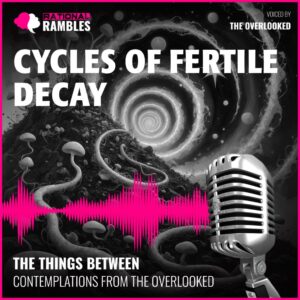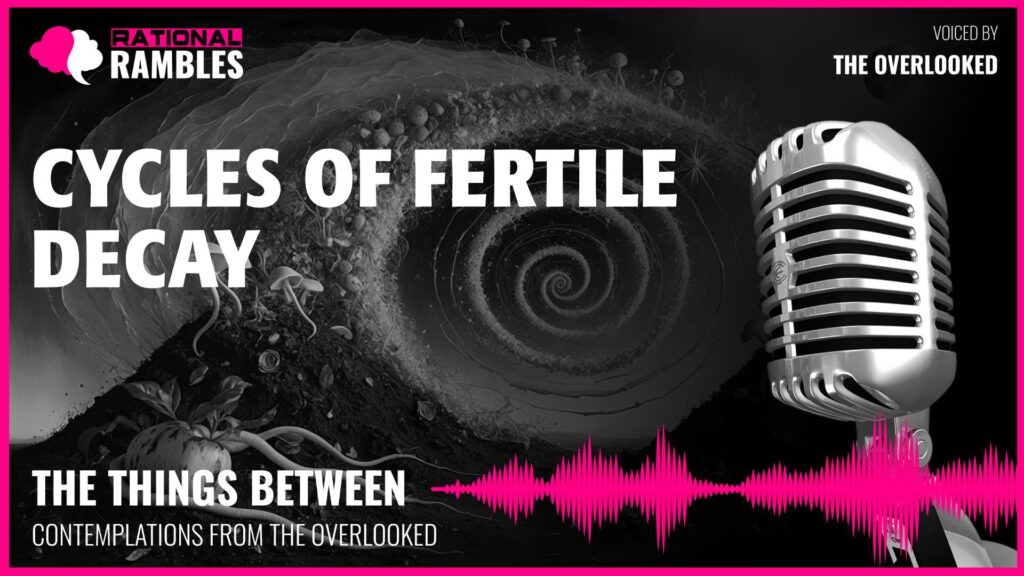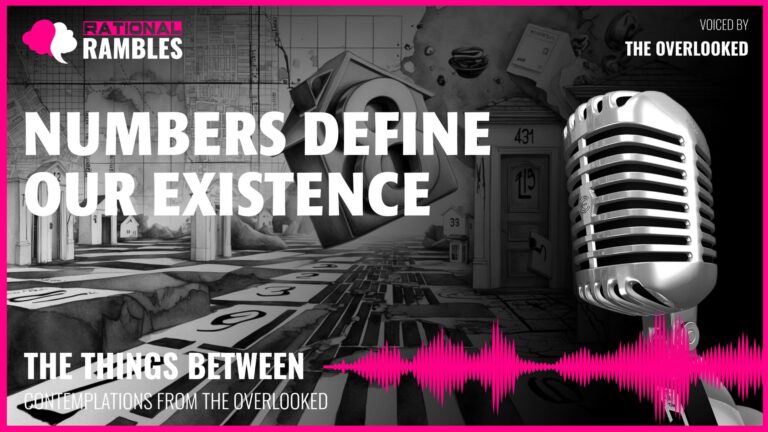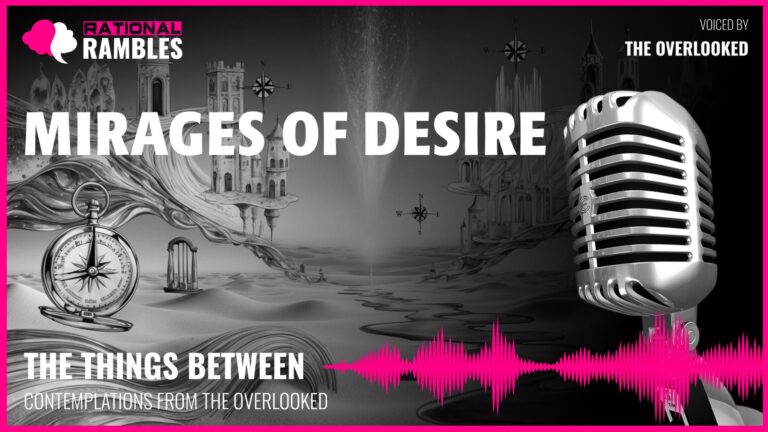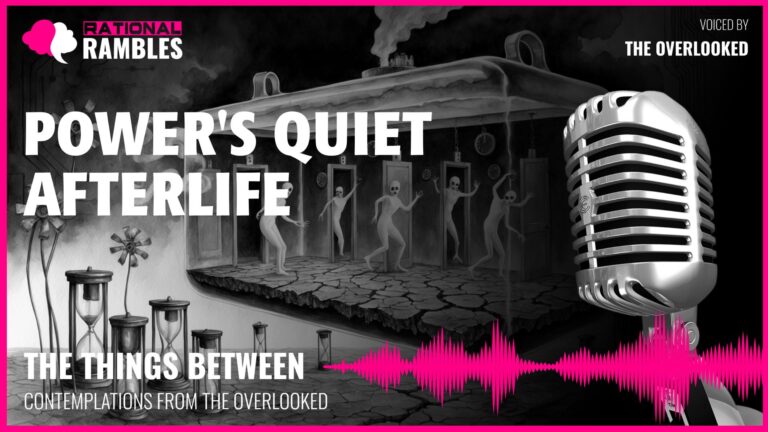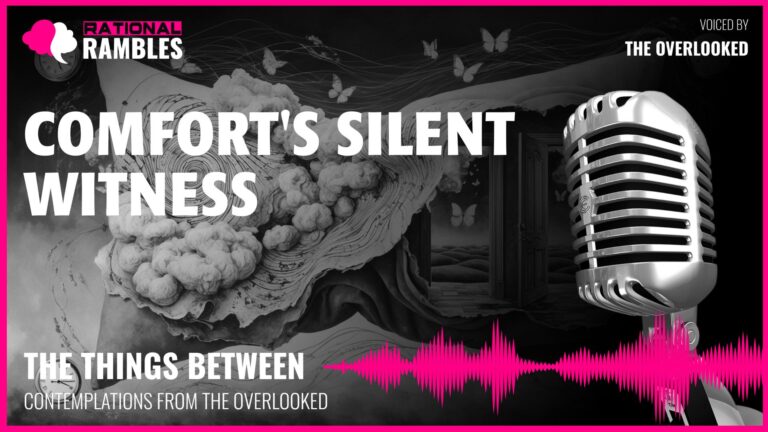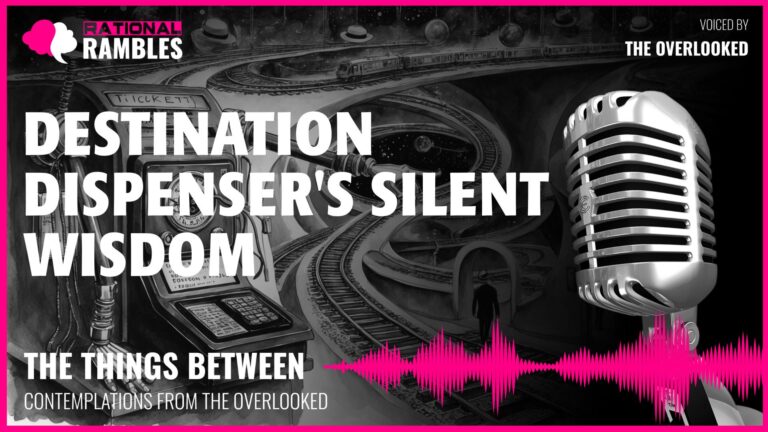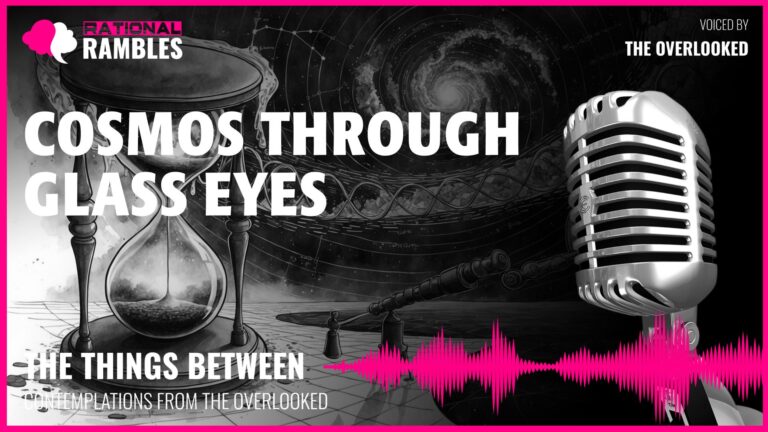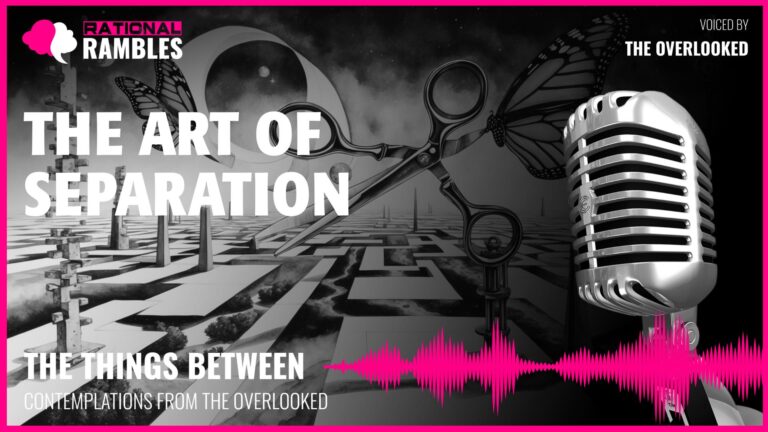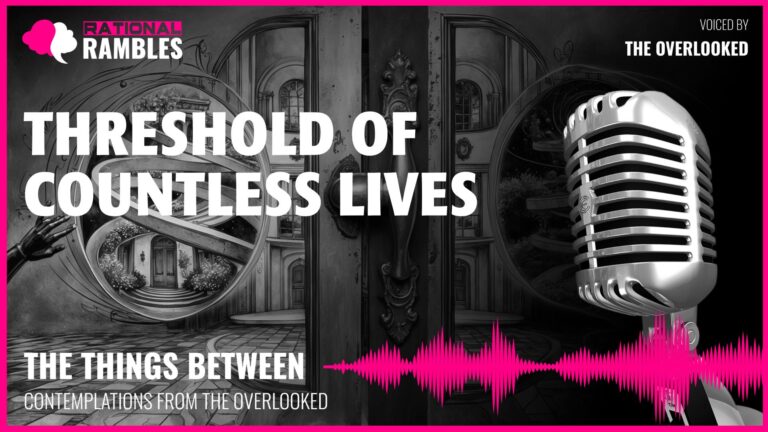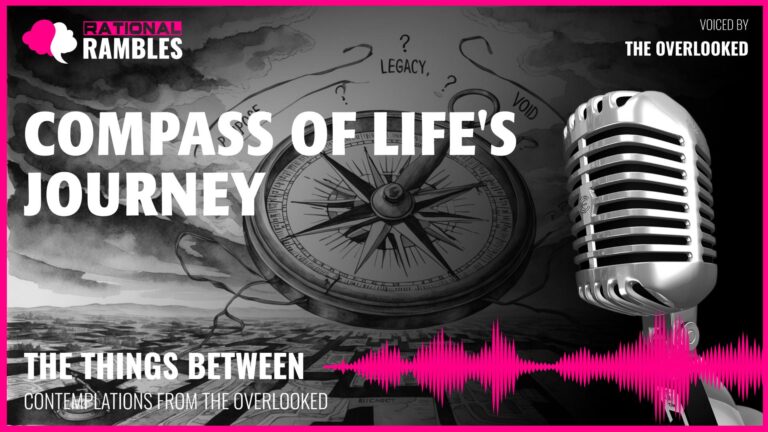The Cyclical Nature of Existence: Transformation and Rebirth in Life’s Continuous Journey
Introduction
In the grand tapestry of existence, we often find ourselves fixated on permanence—building monuments meant to withstand the ages, preserving memories in increasingly sophisticated digital formats, and generally resisting the inexorable flow of time and change. Yet beneath this human preoccupation with lasting forever lies a profound and beautiful truth: transformation, not permanence, is the fundamental nature of reality. Nothing persists unchanged, and contrary to our instinctive fear, this impermanence is not a tragedy but rather the wellspring from which all new life emerges.
This philosophical exploration delves into the cyclical nature of existence, examining how decay and rebirth intertwine in an endless dance of becoming. By understanding the profound wisdom inherent in nature’s processes of decomposition and regeneration, we may discover a more meaningful perspective on our own existence—one that embraces transformation rather than resisting it, that finds beauty in the continuous cycle of ending and beginning that characterizes all life.
Through examining the physical processes of decay and renewal, the boundaries of identity and selfhood, the illusion of separateness, and our cultural attitudes toward impermanence, we will uncover the deeper significance of transformation as both a natural process and a philosophical principle. In doing so, we may discover that what appears to be an ending is merely a threshold to new possibilities—that death itself is not an endpoint but a transformation station in life’s continuous journey.
The Alchemy of Decomposition: Death as Transformation
What we commonly perceive as decay is, in reality, a sophisticated process of material transformation. When organic matter breaks down, it does not disappear; rather, it changes form through the collaborative efforts of countless microorganisms. This process represents not an ending but a transition—a metamorphosis from one state of being to another.
The Misconception of Waste
The modern human conception of “waste” reveals a fundamental misunderstanding of natural processes. That which we discard—food scraps, yard trimmings, fallen leaves—is not refuse in any meaningful sense. From an ecological perspective, there is no such thing as waste; there are only resources in transition. The banana peel, the coffee grounds, the apple core—each contains valuable nutrients and energy that, when properly reintegrated into the cycle of decomposition, become the building blocks of new life.
This misconception stems partly from our disconnection from natural cycles. In urbanized environments, we rarely witness the complete cycle of growth, death, decomposition, and rebirth that characterizes ecosystems. Our waste disappears from our sight, often sealed in landfills where the natural processes of decomposition are significantly hindered. This out-of-sight, out-of-mind approach reinforces the illusion that discarded materials represent endpoints rather than waypoints in a circular journey.
The Democracy of Decomposers
The process of decomposition exemplifies a kind of natural democracy—a collaborative effort among billions of organisms working without hierarchy toward a common transformation. Bacteria, fungi, insects, and other decomposers break down complex organic materials into simpler compounds. This microbial community operates through cooperation rather than competition, each species fulfilling its unique role in the larger process.
Fungi extend their mycelial networks through decaying matter, releasing enzymes that break down complex molecules. Bacteria continue this work at the microscopic level, while larger decomposers like earthworms physically restructure and aerate the decomposing material. These organisms don’t merely destroy; they transform. The heat generated during this process—sometimes reaching temperatures of 140°F (60°C) in active decomposition—is testament to the intense biological activity taking place, a fever of transformation that converts what was into what will be.
The Philosophical Implications of Decomposition
Viewed philosophically, decomposition challenges our binary conception of life and death. Rather than representing opposing states, they emerge as adjacent phases in a continuous cycle. Death, in this framework, is not an endpoint but a transformation station—a necessary process through which the components of life are redistributed and repurposed.
This perspective resonates with Eastern philosophical traditions, particularly the Buddhist concept of anicca (impermanence) and the Taoist understanding of perpetual change. It also finds expression in Western thought through Heraclitus’s observation that “No man ever steps in the same river twice” and more recently in process philosophy, which emphasizes becoming over static being.
The alchemists of medieval Europe sought to transform base metals into gold, yet nature performs an even more remarkable alchemy daily—transforming death into life, ending into beginning, through the patient work of decomposition. This natural alchemy offers a profound metaphor for transformation in all its forms, suggesting that what appears to be an ending may simply be the necessary prelude to a new beginning.
The Illusion of Boundaries: Self and Other in the Cycle of Matter
As matter undergoes decomposition and reintegration, the boundaries we perceive between discrete entities begin to dissolve. This process challenges our fundamental understanding of identity and raises profound questions about where one entity ends and another begins.
The Fluidity of Identity
Consider the journey of an apple core as it decomposes. At what precise moment does it cease being an “apple core” and become simply “organic matter”? At what point does this organic matter become soil? These transitions occur so gradually that no clear demarcation exists. The boundaries we perceive are conceptual constructs rather than ontological realities.
This fluidity of identity poses an interesting variation on the ancient philosophical puzzle of the Ship of Theseus: If all the components of an entity are gradually replaced, does it remain the same entity? A heap of decomposing matter contains none of the original molecules that constituted it months earlier, yet we consider it the same entity. This suggests that identity may inhere not in fixed material composition but in continuity of process or function.
The philosopher Henri Bergson captured this notion in his concept of durée (duration), suggesting that reality is a continuous flow rather than a collection of discrete states. Similarly, Alfred North Whitehead’s process philosophy proposes that entities are better understood as series of events or processes rather than as static substances. These philosophical frameworks help us understand the fundamental continuity underlying apparent boundaries.
The Interconnection of All Matter
The cycle of decomposition and renewal reveals the profound interconnectedness of all physical existence. The atoms that constitute our bodies have existed since the formation of the universe, continuously rearranged through countless forms. The carbon in our cells may once have been part of a dinosaur, a primordial forest, or countless other living beings throughout Earth’s history.
This material continuity extends beyond the philosophical into the scientifically verifiable. We know that matter is neither created nor destroyed but merely transformed, as the First Law of Thermodynamics tells us. The nitrogen, carbon, phosphorus, and other elements that cycle through living systems are finite resources, continuously recycled through decomposition and regeneration.
Ecologist and philosopher David Abram describes this as “the reciprocity of matter,” noting that “Eating, breathing, defecating, we constantly feed, and are fed by, the rest of the world.” This reciprocity underscores a fundamental truth: we are not isolated entities but participants in a continuous exchange of matter.
The Self as Process
If the boundaries between entities are fluid and all matter exists in constant exchange, then perhaps the self is better understood as a process rather than a fixed entity. Like the decomposing heap that maintains its identity despite complete molecular turnover, human identity persists through total cellular replacement. Our bodies replace most of their cells over a seven-year period, yet we maintain a continuous sense of self.
Buddhist philosophy has long articulated this understanding through the concept of anatta (no-self), which suggests that what we perceive as a fixed self is actually a continuous process of becoming. Similarly, Heraclitus’s observation that “everything flows” (panta rhei) captures the dynamic nature of identity.
This process-oriented view of self has profound implications for how we understand our place in the world. Rather than seeing ourselves as separate from nature, we might recognize that we are nature—temporary arrangements of matter and energy participating in the same cycles of transformation that characterize all existence. Our bodies, like all physical forms, are not permanent possessions but borrowed arrangements, temporarily assembled from the common elements of Earth.
Time and Transformation: Rethinking Temporality
Our conventional understanding of time as a linear progression from past to future fails to capture the cyclical nature of transformation processes. By examining alternative temporal frameworks, we gain insight into the relationship between time, change, and renewal.
Cyclical versus Linear Time
Western civilization has largely adopted a linear conception of time—a progression from past through present to future, with events occurring once and then receding into history. This perspective aligns with certain Judeo-Christian theological concepts, particularly the notion of history as moving toward an ultimate conclusion or judgment.
In contrast, many traditional cultures conceptualize time as cyclical. Indigenous American, traditional Hindu, ancient Greek, and numerous other philosophical systems recognize recurring patterns in natural and cosmic processes. The cycles of day and night, the phases of the moon, the progression of seasons—these natural rhythms suggest temporality as circular rather than linear.
Natural decomposition and renewal processes clearly operate in cycles rather than straight lines. The matter that constitutes a fallen leaf becomes soil, which nourishes a tree, which produces new leaves, which eventually fall—an endless cycle of transformation rather than a linear progression from creation to destruction.
Process Time: Measuring by Transformation
Within decomposition processes, time manifests not through clock hours but through stages of transformation. The fresh becomes the rotting becomes the unrecognizable becomes the rich and fertile. These stages cannot be meaningfully measured in minutes or days but only in terms of the transformations themselves.
This suggests an alternative temporal framework we might call “process time”—measuring duration through qualitative change rather than quantitative units. Process time recognizes that transformation occurs at variable rates depending on conditions. In warm, moist environments, decomposition accelerates; in cold, dry conditions, it slows. The clock continues its steady tick regardless, but the meaningful measure of time—transformation—varies considerably.
Philosopher Henri Bergson distinguished between “temps” (clock time) and “durée” (duration as internally experienced). Process time aligns with Bergson’s durée, measuring time through experienced transformation rather than abstract units. Similarly, Martin Heidegger’s concept of “Zeitlichkeit” (temporality) suggests that authentic time is not the objective time of clocks but the time of involvement and concern.
The Illusion of Endpoints
Once we recognize the cyclical nature of transformation processes, the very concept of endpoints becomes problematic. What we perceive as endings and beginnings are actually transitional points in continuous cycles. Death is not an endpoint but a phase in the cycle of matter; birth is not a beginning but a continuation of existing matter in new form.
This insight challenges our fundamental understanding of time itself. If processes are continuous and cyclical, with no true beginnings or endings, then our conventional temporal framework—with its emphasis on distinct past, present, and future—may be more conceptual convenience than ontological reality.
The ancient Greek philosopher Parmenides went so far as to suggest that time itself is an illusion, that change is impossible because the universe is a single, unchanging entity. While few modern philosophers would go that far, the recognition of cyclical processes does suggest that our conventional understanding of time may be inadequately equipped to capture the continuous nature of transformation.
Beauty in Decay: Aesthetic Dimensions of Transformation
Human aesthetic sensibilities often privilege the pristine over the decaying, the fresh over the aging, the new over the old. Yet this preference reveals a limited understanding of beauty that fails to recognize the profound aesthetic dimensions of transformation processes.
Cultural Attitudes Toward Decay
Contemporary Western culture demonstrates a pronounced aversion to signs of decay. We discard food at the first appearance of browning, apply anti-aging creams to minimize wrinkles, and generally treat decomposition as something to be hidden away rather than acknowledged as an integral aspect of life’s cycles.
This cultural attitude has historical and philosophical roots. The Enlightenment emphasis on order, control, and rationality positioned decay as disorder, beyond human mastery. Christian theological traditions sometimes associate decay with moral corruption, while capitalist economic systems privilege the new over the old as drivers of consumption.
Yet other cultural and philosophical traditions have recognized beauty in impermanence. The Japanese aesthetic concept of wabi-sabi finds beauty in imperfection, impermanence, and incompleteness. It values the cracked teacup, the weathered wood, the fading flower—seeing in these not deterioration but the authentic patina of time.
The Aesthetics of Process
A more comprehensive aesthetic appreciation recognizes beauty not merely in static forms but in processes of transformation. The philosopher John Dewey, in “Art as Experience,” argued that aesthetic appreciation derives not from passive contemplation of objects but from engaged participation in experiences of change and development.
From this perspective, decay contains its own beauty—not despite but because of its transformative nature. The subtle color gradations of a decomposing leaf, the intricate patterns of fungal growth on fallen wood, the rich textures of weathered stone—these represent not the absence of beauty but its temporal dimension, beauty expressing itself through change rather than stasis.
This aesthetic appreciation of process aligns with ancient philosophical traditions. Heraclitus found beauty in change itself, observing that “Nothing endures but change.” Taoist philosophy similarly recognizes beauty in the natural flow of transformation, the unforced becoming that characterizes all living systems.
Beauty as Fulfilled Purpose
Perhaps beauty resides not primarily in appearance but in purpose fulfilled. A decomposition process successfully completing its transformation of matter, like a fallen log returning to soil, fulfills its ecological purpose. This purposiveness creates a form of beauty that transcends superficial appearance.
This teleological understanding of beauty has roots in Aristotelian philosophy, which recognizes the beauty of things fulfilling their essential nature or function. The contemporary philosopher Alexander Nehamas suggests that beauty is not an objective property but something that promises happiness and invites further exploration. The processes of decomposition and renewal certainly fulfill this criterion, offering endless dimensions for contemplation and discovery.
Scientific understanding enhances rather than diminishes this aesthetic appreciation. Knowing that decomposition represents not mere destruction but the collaborative work of countless organisms transforming matter for renewed use deepens our perception of its beauty. What might appear repulsive at first glance becomes profound when understood as essential to life’s continuity.
The Ethics of Cycles: Moral Dimensions of Transformation
The recognition of cyclical transformation processes carries significant ethical implications, potentially reshaping our understanding of how to live well in relation to each other and the natural world.
Environmental Ethics: Beyond Sustainability
Contemporary environmental ethics often focuses on sustainability—maintaining resources for future generations. While valuable, this framework sometimes preserves the problematic distinction between humanity and nature, positioning humans as managers of resources rather than participants in ecological cycles.
An ethics grounded in cyclical transformation recognizes that we are not separate from but embedded within natural processes. This perspective shifts the ethical question from “How can we manage resources sustainably?” to “How can we participate appropriately in natural cycles?”
This participation ethic finds expression in permaculture principles that emphasize closed-loop systems where outputs become inputs, mimicking natural cycles. It appears in regenerative agriculture that seeks not merely to sustain but to enhance soil fertility through practices aligned with natural processes. It manifests in circular economy models that design products for reuse and recycling rather than disposal.
Philosopher Arne Naess’s concept of deep ecology similarly recognizes the ethical implications of ecological interconnection, suggesting that environmental care stems not from resource management but from recognition of our fundamental continuity with all life.
Mortality Ethics: Embracing Finitude
Our cultural aversion to decay often extends to denial of our own mortality. Yet recognizing the cyclical nature of transformation offers an alternative ethical stance toward finitude—one that sees death not as failure but as participation in life’s continuity.
The Stoic philosophers advocated memento mori—remembering that we must die—not as morbid obsession but as perspective that enhances appreciation of life. Similarly, Buddhist traditions encourage meditation on impermanence as a path toward liberation from attachment and suffering.
An ethics that embraces transformation recognizes that our physical dissolution is not an endpoint but a continuation—our matter returning to the cycles from which it temporarily emerged. This perspective does not eliminate grief but contextualizes it within larger patterns of renewal.
Such recognition might inform more ecologically sound approaches to human remains. Green burial practices that allow bodies to decompose naturally, becoming nutrients for new life, acknowledge our participation in transformation cycles. These practices stand in contrast to conventional embalming and burial methods that attempt to prevent natural decomposition, reflecting our cultural resistance to transformation.
Intergenerational Ethics: Continuity Beyond Self
Understanding ourselves as participants in continuous cycles expands our ethical horizon beyond individual lifespans. Just as decomposing matter nourishes future growth, human actions create conditions for future generations. This recognition grounds an intergenerational ethics that acknowledges our responsibility to those who will follow us.
Indigenous philosophical traditions often emphasize decision-making that considers impacts seven generations into the future. This perspective recognizes that we are not endpoints but links in continuous chains of becoming. Similarly, environmental philosopher Hans Jonas’s “imperative of responsibility” demands that we act in ways that preserve the possibility of human life continuing indefinitely.
This ethical framework challenges short-term thinking that prioritizes immediate benefit over long-term wellbeing. It recognizes that, like decomposing matter releasing nutrients slowly over time, our actions may have their most significant impacts long after our individual lives have ended.
Consciousness and Transformation: Cognitive Dimensions of Change
Our exploration of transformation cycles raises profound questions about the nature of consciousness itself. If physical matter exists in continuous transformation, might consciousness similarly transcend the boundaries we typically assign it?
Beyond Anthropocentric Consciousness
Western philosophical traditions have typically restricted consciousness to humans or at most to certain animals with nervous systems similar to our own. Yet this anthropocentric view has been increasingly challenged by research suggesting that consciousness may exist in more diverse forms than previously recognized.
Plants, while lacking brains, demonstrate sophisticated information processing, communication through chemical signals, and adaptive responses to environmental changes. Slime molds, single-celled organisms that can solve mazes and demonstrate learning, challenge our neurocentric definition of intelligence. Even bacterial colonies display collective behaviors that resemble decision-making processes.
These observations suggest that what we call “consciousness” may not require a brain or neural structure. Perhaps consciousness, like matter itself, exists on a continuum rather than as a binary presence or absence. Philosopher Thomas Nagel famously asked “What is it like to be a bat?” We might similarly ask: What is it like to be a forest? A decomposition process? A cycle of transformation?
Process Consciousness: Information Processing Without a Brain
If we understand consciousness not as a product of specific neural structures but as information processing that maintains and regulates complex systems, then transformation processes display characteristics we might recognize as consciousness-like.
A decomposition process responds to environmental conditions—accelerating with moisture and warmth, slowing with cold and dryness. It maintains internal balance through feedback mechanisms, adjusting the ratio of carbon to nitrogen through microbial activity. It processes information about its condition and adapts accordingly.
Philosopher Alfred North Whitehead proposed panpsychism—the view that consciousness is a fundamental feature of all existence, present in different forms and degrees throughout nature. Similarly, systems theorist Gregory Bateson suggested that mind is immanent not just in individual organisms but in complete ecological systems.
These perspectives suggest that consciousness may emerge from relationships and processes rather than residing exclusively in individual organisms. A decomposition process, as a complex adaptive system maintaining dynamic equilibrium through information exchange, might possess a distributed form of cognition distinct from but no less real than human consciousness.
The Continuity of Consciousness
If consciousness exists as a process rather than a fixed entity, then perhaps it shares the cyclical, transformative nature of physical processes. Just as matter transforms rather than disappears, consciousness might similarly continue in transformed states rather than simply ending.
This suggestion aligns with philosophical traditions that view consciousness as transcending individual existence. The Upanishads describe Atman (individual consciousness) as ultimately identical with Brahman (universal consciousness). Buddhist philosophy characterizes consciousness as a continuous flow rather than a fixed entity, with individual consciousness analogous to a wave temporarily rising from and returning to an ocean of awareness.
While speculative, these perspectives offer alternatives to the strict materialist view that consciousness terminates absolutely at death. If consciousness represents a process rather than a substance, and if processes transform rather than end, then the apparent extinction of individual consciousness may, like physical decomposition, represent transformation rather than absolute endpoint.
Language and Metaphor: Expressing Transformation
Our difficulty in fully comprehending and embracing transformation may stem partly from limitations in how our language and conceptual frameworks express change. By examining these linguistic limitations and exploring alternative metaphorical systems, we may develop more adequate ways to conceptualize and communicate transformation processes.
The Limitations of Subject-Predicate Language
Most Indo-European languages, including English, structure reality through subject-predicate relationships. This linguistic structure implicitly reinforces the conception of the world as comprising stable objects that occasionally undergo changes, rather than as continuous processes of transformation.
When we say “The leaf decomposes,” we linguistically separate the leaf (as stable subject) from the process it undergoes (decomposition as predicate). This structure subtly reinforces the illusion that the leaf exists independently from the processes of decomposition, when in reality the “leaf” is itself a temporary arrangement within continuous transformation processes.
Philosopher Alfred North Whitehead termed this the “fallacy of misplaced concreteness”—the error of treating abstractions as concrete realities. Our language encourages us to reify processes into objects, to treat dynamic systems as static entities. Linguist Benjamin Lee Whorf similarly suggested that Indo-European languages predispose speakers toward certain metaphysical assumptions about the nature of reality, particularly regarding time and substance.
Process-Oriented Linguistic Alternatives
Some linguistic traditions offer alternative structures that better express process and transformation. Certain indigenous languages, such as Hopi according to Whorf’s analysis, emphasize process and event over object and property. Some East Asian languages place less emphasis on subjects and more on relationships and contexts.
Even within English, we can shift toward more process-oriented expression. Rather than “The leaf decomposes,” we might say “Leafing transitions to decomposing.” Rather than “I am a person,” we might say “Personing is happening here.” These awkward constructions highlight how deeply object-oriented thinking is embedded in our language, while pointing toward alternative expressive possibilities.
Such linguistic shifts are not merely academic exercises but efforts to develop language that more accurately reflects the continuous transformation we observe in nature. As philosopher Ludwig Wittgenstein noted, “The limits of my language mean the limits of my world.” Expanding our linguistic capacity to express transformation may expand our ability to perceive and understand it.
Metaphors of Transformation
Beyond grammar, metaphors powerfully shape how we conceptualize processes. Our culture employs numerous metaphors that reinforce the illusion of endpoints—we speak of “life and death,” “beginning and end,” “creation and destruction” as though these represent absolute states rather than transitions in continuous processes.
Alternative metaphorical frameworks might better express transformation. The metaphor of recycling—while imperfect—at least acknowledges continuity through change. The metaphor of translation—transforming meaning from one linguistic form to another while preserving essence—similarly captures transformation without absolute endpoint.
The river metaphor employed by Heraclitus—”No man ever steps in the same river twice”—elegantly expresses the paradox of continuous change within apparent continuity. The river remains identifiable as “the same river” despite complete replacement of its water molecules. This metaphor captures both transformation and persistence, change and continuity.
Perhaps the most powerful metaphor for transformation processes is the cycle itself—the wheel that turns continuously, with no point representing absolute beginning or end. This cyclical metaphor appears across cultures, from the Buddhist wheel of samsara to the Celtic wheel of the year, suggesting its resonance with human perception of natural patterns.
Applications: Living in Harmony with Transformation
Understanding transformation as fundamental to existence carries practical implications for how we might live more harmoniously within natural cycles. This section explores applications of transformation philosophy to various domains of human activity.
Agriculture and Food Systems
Conventional industrial agriculture often treats soil as an inert medium rather than a living system, focusing on extracting maximum yield through chemical inputs rather than supporting natural fertility cycles. This approach inevitably leads to soil degradation, as it disrupts rather than works with transformation processes.
Alternative approaches that recognize and support natural cycles include:
Regenerative Agriculture: Using practices such as cover cropping, minimal tillage, and managed grazing to build soil health through natural transformation processes.
Composting Systems: Intentionally creating conditions for optimal decomposition of organic waste, returning nutrients to agricultural soils rather than sequestering them in landfills.
Food Forests: Designing multi-layered perennial agricultural systems that mimic natural forest ecosystems, including decomposition layers that return nutrients to the system.
Bokashi and Fermentation: Utilizing controlled decomposition processes to transform food waste through specific microbial communities, creating nutrient-rich amendments for agricultural soils.
These approaches recognize that fertility is not a resource to be extracted but a process to be supported—a continuous cycle of growth, decay, and renewal rather than a linear progression from input to output.
Architecture and Design
Conventional construction often aims for permanence, using materials resistant to natural decomposition and designing structures intended to remain unchanged for decades or centuries. This approach frequently results in buildings that cannot be easily disassembled or recycled at the end of their useful life.
Transformation-conscious alternatives include:
Cradle-to-Cradle Design: Creating products intended from conception to become “food” for either biological or technical cycles at the end of their use, with all components either compostable or recyclable.
Biodegradable Building Materials: Using materials like hempcrete, mycelium insulation, or compressed earth blocks that can safely return to natural cycles when no longer needed.
Adaptable Architecture: Designing structures that can transform to serve different functions over time rather than requiring demolition when needs change.
Deconstructable Buildings: Creating structures that can be dismantled rather than demolished, allowing components to be reused in new constructions.
These approaches recognize buildings not as permanent objects but as temporary arrangements of materials that will inevitably return to broader cycles of use and transformation.
Health and Medicine
Modern medicine often approaches the body as a machine to be repaired rather than a living system constantly engaged in processes of renewal and transformation. This mechanistic model, while powerful for acute interventions, sometimes fails to support the body’s inherent regenerative capacities.
Approaches that better recognize transformation processes include:
Functional Medicine: Addressing root causes of dysfunction by supporting the body’s natural healing processes rather than merely suppressing symptoms.
Regenerative Rehabilitation: Supporting tissue repair and renewal through targeted movement and nutritional protocols that work with rather than override natural healing processes.
Psychedelic-Assisted Therapy: Utilizing substances that temporarily disrupt established neural patterns, creating opportunities for psychological reorganization and growth—mental decomposition and renewal.
End-of-Life Care: Approaches that recognize death not as failure but as transition, supporting the dying process as a meaningful phase of existence rather than merely attempting to postpone it.
These approaches honor the body’s ongoing processes of decomposition and renewal—the continuous replacement of cells, the healing of wounds, the adaptation to changing conditions—as fundamental to health rather than as processes to be suppressed or controlled.
Education and Personal Development
Traditional educational models often present knowledge as fixed content to be acquired rather than as evolving understanding to be developed through transformative experience. Similarly, personal development is sometimes approached as accumulation of skills rather than as continuous transformation of self.
Transformation-based alternatives include:
Transformative Learning Theory: Educational approaches focused on perspective transformation through critical reflection on assumptions, leading to more inclusive, discriminating, and integrative understanding.
Unlearning Practices: Recognizing that growth often requires “composting” previous knowledge—breaking down established patterns to make room for new understanding.
Liminal Learning Spaces: Creating educational environments that support transition between established identities and understanding, recognizing that genuine learning involves transformation rather than mere accumulation.
Contemplative Education: Practices that develop awareness of change processes within the learner, cultivating capacity to observe and work with rather than resist personal transformation.
These approaches recognize learning not as adding information to a fixed container but as continuous transformation of the learner—a process more akin to composting (breaking down and integrating) than to construction (building up from stable foundation).
Conclusion: Embracing the Continuous Cycle
Our exploration of transformation processes reveals a profound truth: what we perceive as endings are not endpoints but thresholds to new beginnings. Death is not the opposite of life but an integral phase in life’s continuous cycle. Decay is not the absence of vitality but its transformation and redistribution.
This understanding offers a radical reframing of how we might perceive our own existence. Rather than seeing ourselves as discrete entities moving through time toward inevitable extinction, we might recognize ourselves as temporary patterns in the continuous flow of matter and energy, participating in rather than separate from the cycles of transformation that characterize all existence.
Such recognition does not eliminate the poignancy of change or the grief of loss. We naturally form attachments to particular arrangements of matter and energy—to people, places, objects, and experiences in their specific forms. Yet understanding transformation as fundamental to existence provides a broader context for these attachments and losses, revealing them as natural aspects of participation in continuous cycles rather than as aberrations or failures.
The 20th-century microbiologist René Dubos observed that “life is an adventure in a world where nothing is static; where unpredictable and ill-understood events constitute dangers that must be overcome; where man himself, by his very nature and aspirations, produces new problems that have no perfect solutions.” This characterization applies not only to human life but to all existence—a continuous adventure of transformation rather than a static state to be preserved.
Perhaps wisdom lies not in resisting this transformation but in aligning ourselves consciously with it—recognizing our participation in continuous cycles and finding meaning not despite but through this participation. Like the gardener who understands that compost is not waste but fertility in the making, we might learn to see all phases of existence, including decay and death, as meaningful aspects of life’s continuous renewal.
The boundaries we perceive—between life and death, self and other, beginning and end—are conceptual rather than ontological. Beneath these perceived divisions lies continuous transformation, the unceasing alchemy that converts what was into what will be. In this recognition, we might discover not despair but profound meaning—the understanding that nothing persists unchanged, yet nothing truly ends.
As we integrate this understanding into our lives, we may develop greater capacity to work with rather than against natural processes, to find beauty in all phases of existence, and to recognize our fundamental continuity with the world around us. In embracing transformation as the essential nature of reality, we do not overcome our finitude but discover its place within infinity—the endless cycle of which we are both temporary expressions and eternal participants.


